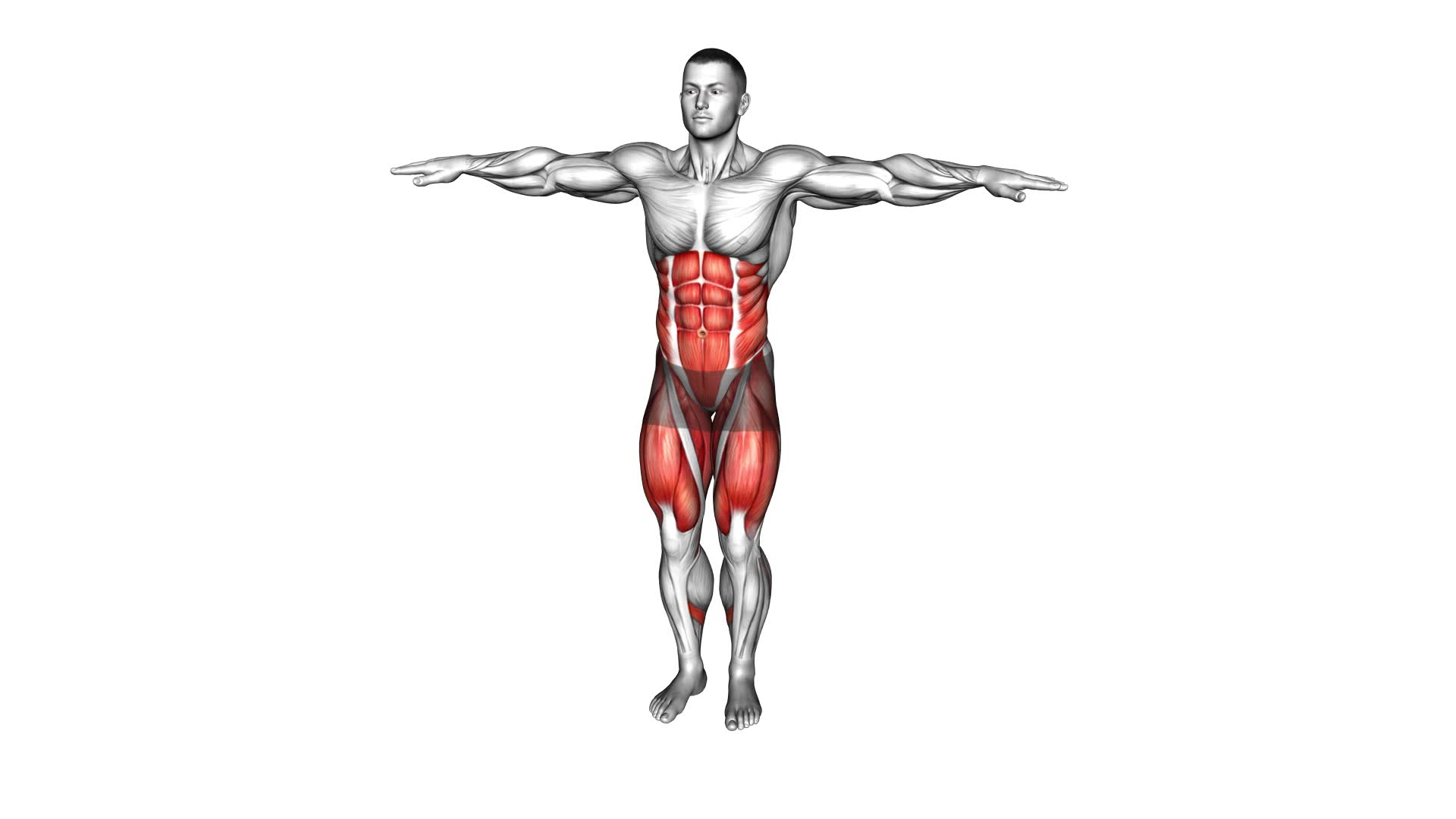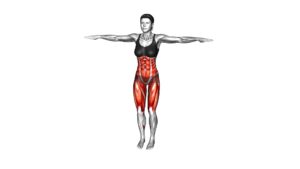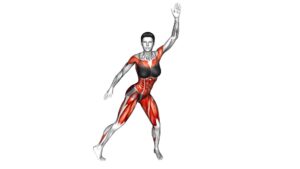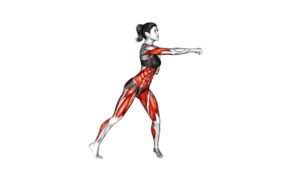Diagonal Lunge – Video Exercise Guide & Tips

Are you looking to level up your workout routine?
Watch This Exercise Video
Then the Diagonal Lunge is just what you need!
In this video exercise guide, we'll show you how to perform this dynamic move with proper form and technique.
Whether you're a beginner or a seasoned fitness enthusiast, we've got variations to challenge you and tips to help you avoid common mistakes.
Get ready to maximize your results and take your fitness journey to new heights!
Key Takeaways
- Targets multiple muscle groups in the lower body (glutes, quadriceps, hamstrings, calves)
- Improves balance, stability, and coordination
- Can be modified for beginners to ensure proper form and prevent injury
- Incorporate effective lunge modifications to add variety and challenge
Benefits of the Diagonal Lunge
Discover the numerous benefits you can experience from incorporating the diagonal lunge into your workout routine.
The diagonal lunge is a highly effective exercise that targets multiple muscle groups in your lower body. It primarily engages your glutes, quadriceps, hamstrings, and calves, making it an excellent choice for strengthening and toning these areas.
By incorporating the diagonal lunge into your routine, you can develop better balance, stability, and coordination, as it requires you to move in multiple planes of motion. This exercise also helps improve your hip mobility and flexibility.
For beginners, modifying the diagonal lunge is essential to ensure proper form and prevent injury. Start by performing the exercise without weights to focus on mastering the movement. You can also reduce the range of motion by taking smaller steps and not lunging as deeply. Another modification is to hold onto a stable surface, such as a chair or wall, for added support and balance.
As you become more comfortable and confident, gradually increase the intensity by adding weights or increasing the depth of the lunge.
Incorporating the diagonal lunge into your workout routine can yield significant benefits for your lower body strength, stability, and mobility. Remember, proper form and gradual progression are key to maximizing the benefits and minimizing the risk of injury.
Proper Form and Technique
To perform the diagonal lunge with proper form and technique, it's important to consistently engage your core and maintain a controlled movement throughout the exercise. One common misconception is that the diagonal lunge is solely a lower body exercise. However, it actually activates multiple muscle groups, including the glutes, quadriceps, hamstrings, and core muscles.
To begin, stand with your feet hip-width apart and take a step forward and to the right, forming a diagonal line with your body. Keep your chest lifted and shoulders relaxed. As you lower your body into the lunge position, make sure your front knee is directly above your ankle and your back knee is bent at a 90-degree angle. Engage your core by pulling your belly button towards your spine and maintaining a neutral spine throughout the movement.
To return to the starting position, push through your front heel and engage your glutes and quadriceps. Keep your movements controlled and avoid using momentum to complete the exercise. Remember to breathe throughout the movement to maintain proper form and technique.
Variations to Challenge Yourself
To challenge yourself, try incorporating variations of the diagonal lunge into your workout routine.
These advanced modifications will help increase the intensity and effectiveness of your lunges, giving you a more challenging workout.
One way to challenge yourself is by adding weight to your lunges. You can hold dumbbells in each hand or wear a weighted vest to make the exercise more difficult. This will engage your muscles even further, helping you build strength and endurance.
Another option is to incorporate equipment such as a resistance band or a stability ball. Using a resistance band around your thighs can increase the resistance and target your muscles in different ways. Similarly, performing diagonal lunges on a stability ball will challenge your balance and stability, intensifying the exercise.
Additionally, you can try performing jumping lunges. This explosive movement adds a plyometric element to the exercise, increasing the cardiovascular demand and working your muscles in a different way.
Remember to always maintain proper form and technique when performing advanced modifications. Start with lighter weights or lower resistance and gradually increase as you become more comfortable and confident with the exercises. Challenge yourself, but listen to your body and make adjustments as needed.
Common Mistakes to Avoid
To ensure proper form and maximize the effectiveness of your diagonal lunges, it's important to be aware of common mistakes to avoid. By avoiding these mistakes, you can reduce the risk of injury and get the most out of your workout.
One common mistake is allowing your knee to go past your toes during the lunge. This puts unnecessary strain on your knee joint and can lead to pain or injury. To fix this, focus on maintaining a 90-degree angle with your front knee as you lunge.
Another mistake is collapsing your chest and rounding your shoulders forward. This can put strain on your back and compromise your form. Instead, keep your chest lifted and shoulders back throughout the movement.
Finally, avoid rushing through the exercise and sacrificing proper form. It's important to perform each lunge with control and intention.
Now that you know the common mistakes to avoid, let's move on to some tips for maximizing your results.
Tips for Maximizing Your Results
To maximize your results with diagonal lunges, focus on proper form and incorporate these tips into your workout routine.
First, consider incorporating effective lunge modifications to add variety and challenge to your workouts. One modification is to add weights, such as dumbbells or kettlebells, to increase resistance and strengthen your muscles further. Another modification is to perform the diagonal lunge on an unstable surface, like a balance board or Bosu ball, to engage your core and improve balance.
Additionally, it's important to incorporate diagonal lunges into a full body workout routine. This exercise targets multiple muscle groups, including the quadriceps, hamstrings, glutes, and core. To maximize your results, combine diagonal lunges with other exercises that work different muscle groups. For example, you can pair diagonal lunges with exercises like push-ups, planks, or shoulder presses to create a well-rounded workout.
Remember to always maintain proper form throughout the exercise. Keep your chest up, shoulders back, and core engaged. Step diagonally forward with one leg, lowering your body until your front thigh is parallel to the ground. Push through your front heel to return to the starting position. Repeat on the other side.
Frequently Asked Questions
How Many Calories Can You Burn by Doing Diagonal Lunges?
Diagonal lunges are a great exercise for overall fitness. They can help you burn calories and improve your cardiovascular health. By incorporating proper form and variations, you can target different muscle groups, such as your glutes, quads, and hamstrings.
This exercise also improves your balance and stability. So, if you're looking to burn calories and enhance your overall fitness, diagonal lunges are a fantastic choice.
Can Diagonal Lunges Help Improve Balance and Stability?
Diagonal lunges can help improve your balance and stability. By incorporating this exercise into your fitness routine, you can enhance your coordination and strengthen your lower body.
This exercise targets multiple muscle groups, including your quads, glutes, and hamstrings, helping to build strength and stability in your legs.
Are Diagonal Lunges Suitable for All Fitness Levels?
Diagonal lunges can be suitable for all fitness levels. They offer modifications to accommodate beginners and help build strength, balance, and stability. Diagonal lunge modifications can include reducing the range of motion or using lighter weights.
Beginners can benefit from this exercise by improving lower body strength and coordination. It's important to start with proper form and gradually increase intensity as you progress. Consult a fitness professional for personalized guidance.
Can Diagonal Lunges Help Strengthen the Core Muscles?
Diagonal lunges are a great exercise for strengthening your core muscles. By incorporating diagonal movements into your lunges, you engage your abdominal muscles and obliques, helping to improve stability and balance.
The benefits of diagonal lunges go beyond just the core. They also target the glutes, quads, and hamstrings, making it a well-rounded exercise for overall lower body strength.
How Often Should Diagonal Lunges Be Incorporated Into a Workout Routine for Optimal Results?
For optimal results, it's important to incorporate diagonal lunges into your workout routine with the right frequency. The frequency of performing diagonal lunges depends on your fitness level and goals.
It's generally recommended to do them 2-3 times a week. However, you can modify the frequency based on your specific needs and preferences. Remember to always listen to your body and make adjustments accordingly.
Incorporating diagonal lunges regularly will help improve your overall strength and stability.
Conclusion
In conclusion, the diagonal lunge is a highly effective exercise that targets multiple muscle groups and improves overall lower body strength and stability. By following proper form and technique, you can maximize the benefits of this exercise and avoid common mistakes.
Additionally, incorporating variations into your routine can help challenge yourself and continuously progress. Remember to listen to your body and adjust the intensity as needed.
With consistency and dedication, you can achieve great results with the diagonal lunge.

Author
Years ago, the spark of my life’s passion ignited in my mind the moment I stepped into the local gym for the first time. The inaugural bead of perspiration, the initial endeavor, the very first surge of endorphins, and a sense of pride that washed over me post-workout marked the beginning of my deep-seated interest in strength sports, fitness, and sports nutrition. This very curiosity blossomed rapidly into a profound fascination, propelling me to earn a Master’s degree in Physical Education from the Academy of Physical Education in Krakow, followed by a Sports Manager diploma from the Jagiellonian University. My journey of growth led me to gain more specialized qualifications, such as being a certified personal trainer with a focus on sports dietetics, a lifeguard, and an instructor for wellness and corrective gymnastics. Theoretical knowledge paired seamlessly with practical experience, reinforcing my belief that the transformation of individuals under my guidance was also a reflection of my personal growth. This belief holds true even today. Each day, I strive to push the boundaries and explore new realms. These realms gently elevate me to greater heights. The unique combination of passion for my field and the continuous quest for growth fuels my drive to break new ground.







